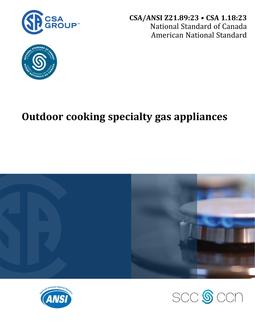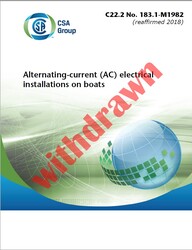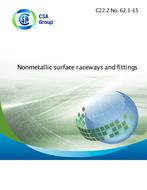Click here to purchase
Z245.20 Series-14 – Plant-applied external coatings for steel pipe
Preface
This is the second edition of the CSA Z245.20 Series, Plant-applied external coatings for steel pipe, which consists of the seventh edition of CSA Z245.20, Plant-applied external fusion bond epoxy coating for steel pipe, the sixth edition of CSA Z245.21, Plant-applied external polyethylene coating for steel pipe, and the second edition of CSA Z245.22, Plant-applied external polyurethane foam insulation coating for steel pipe. This edition of Z245.20 supersedes the previous editions published in 2010, 2006, 2002, 1998, 1992, and 1986; this edition of CSA Z245.21 supersedes the previous editions published in 2010, 2006, 2002, 1998, and 1992; and this edition of CSA Z245.22 supersedes the previous edition published in 2010. CSA Z245.20 deals with the requirements for plant-applied external fusion bond epoxy coating for steel pipe. The main differences from the previous edition are as follows: (a) the standard product ordering requirements have been revised; (b) the requirements for surface preparation and end finish have been revised; (c) the acceptance criteria for holiday inspection have been revised; (d) new requirements for visual coating inspection have been added; (e) the requirements for the repair of coating holidays have been revised; (f) the requirements for markings have been revised; (g) the requirements for the repair of coating damaged during handling and storage have been revised; (h) the test procedures to determine the thermal properties of epoxy powders have been revised; (i) the water type used in cathodic disbondment tests procedures have been defined; (j) the test procedures to determine the flexibility of coatings have been revised; (k) the equipment allowance for test procedures to determine the adhesion of coatings have been revised; (l) the test procedures to determine the gouge resistance of coatings have been revised; (m) Table 2 – acceptance criteria for adhesion tests for System 1B have been revised; (n) Table 3 – adhesion tests and acceptance criteria have been revised; (o) Table 4 – adhesion tests and acceptance criteria have been revised; (p) new Table 9 – Fusion bond epoxy coating repair criteria has been added; (q) Figure 3 – Preliminary DSC scans for unknown powder has been revised; (r) Figures 4 and 5 – Thermal scans of epoxy powder and coating, have been revised; and (s) Figure 6 – Interfacial contamination comparison chart, has been added. CSA Z245.21 deals with the requirements for plant-applied external polyethylene coating for steel pipe. The main differences from the previous edition are as follows: (a) Systems A1 and A2 have been combined into single System A; (b) the definition of compounded polyethylene has been revised; (c) the standard product ordering requirements have been revised; (d) the general requirements for materials certification and identification have been revised; (e) the requirements for surface preparation and end finish have been revised; (f) the acceptance criteria for holiday inspection have been revised; (g) the requirements for the repair of coated pipe have been revised; (h) the requirements for the repair of coating damaged during handling and storage have been revised; (i) the requirements for the equipment and procedures for cathodic disbondment test have been revised; (j) the requirements for the equipment for the peel adhesion test have been revised; (k) Table 1 – acceptance criteria for peel adhesion test have been revised; (l) Table 3 – the testing frequency has been revised (m) Table 10 – acceptance criteria for peel adhesion test have been revised; and (n) Table 11 – new polyethylene coating repair requirements have been added. CSA Z245.22 deals with the requirements for plant-applied external polyurethane foam insulation coating for steel pipe. The main differences from the previous edition are as follows: (a) requirements for foam insulation systems involving leak detection and monitoring systems (LDMS) have been added to the scope and body of the Standard; (b) definitions in the Standard have been revised or expanded; (c) the standard and optional product ordering requirements have been revised; (d) the requirements for the qualification of foam insulation coating systems by the applicator have been revised; (e) the requirements for surface preparation and end finish have been revised; (f) the requirements for inspection and testing have been revised; (g) the requirements for the repair of coated pipe have been revised; (h) the requirements for the repair of coating damaged during handling and storage have been revised; (i) the requirements for markings have been revised; (j) the requirements for coating test procedures have been revised; (k) a new external polyethylene jacket bend back test has been added; (l) Table 2 – coating system qualification tests have been revised; (m) Table 5 – the vicat softening point test has been removed; (n) Tables 6 and 7 – new requirements for polyethylene jacket thickness have been added; (o) Tables 8, 9 and 10 – requirements for incoming material and production tests have been revised; (p) Figures 3 and 4 – axial shear test configurations have been revised; (q) Annex A on Polyolefin tape coatings has been revised; and (r) the surface preparation and visual inspection requirements in Annex B have been revised. ———————————————————————————- Z245.20-14 – Plant-applied external fusion bond epoxy coating for steel pipe
Scope
1.1 This Standard covers the qualification, application, inspection, testing, handling, and storage of materials required for plant-applied fusion bond epoxy (FBE) coating applied externally to bare steel pipe. The coated pipe is intended primarily for buried or submerged service for oil or gas pipeline systems. 1.2 This Standard covers the following coating systems: (a) System 1A: single-layer FBE with a glass transition temperature of 115 ?C or less; (b) System 1B: single-layer FBE with a glass transition temperature greater than 115 ?C; (c) System 2A: two-layer FBE with an anti-corrosion coating and a protective overcoat; (d) System 2B: two-layer FBE with an anti-corrosion coating and an abrasion-resistant overcoat; (e) System 2C: two-layer FBE with an anti-corrosion coating and an anti-slip overcoat; and (f) System 3: three-layer FBE with an anti-slip overcoat applied over an anti-corrosion coating and a protective overcoat. 1.3 In CSA Standards, “shall” is used to express a requirement, i.e., a provision that the user is obliged to satisfy in order to comply with the standard; “should” is used to express a recommendation or that which is advised but not required, and “may” is used to express an option or that which is permissible within the limits of the standard. Notes accompanying clauses do not include requirements or alternative requirements; the purpose of a note accompanying a clause is to separate from the text explanatory or informative material. Notes to tables and figures are considered part of the table or figure and may be written as requirements. Annexes are designated normative (mandatory) or informative (non-mandatory) to define their application. ———————————————————————————- Z245.21-14 – Plant-applied external polyethylene coating for steel pipe
Scope
1.1 This Standard covers the qualification, application, inspection, testing, handling, and storage of materials required for plant-applied polyethylene coating applied externally to steel pipe, whereby an adhesive is interposed between a bare or epoxy-primed pipe and the polyethylene. The coated pipe is intended primarily for buried or submerged service for oil or gas pipeline systems. 1.2 This Standard covers the following coating systems: (a) System A: a coating that consists of an adhesive and a polyethylene outer sheath (see Table 1); (b) System B1: a coating that consists of a liquid or powdered epoxy primer, a polymeric adhesive, and a polyethylene outer sheath; and (c) System B2: a coating that consists of a powdered epoxy primer, a powdered copolymer adhesive, and a powdered polyethylene outer layer. 1.3 In CSA Standards, “shall” is used to express a requirement, i.e., a provision that the user is obliged to satisfy in order to comply with the standard; “should” is used to express a recommendation or that which is advised but not required, and “may” is used to express an option or that which is permissible within the limits of the standard. Notes accompanying clauses do not include requirements or alternative requirements; the purpose of a note accompanying a clause is to separate from the text explanatory or informative material. Notes to tables and figures are considered part of the table or figure and may be written as requirements. Annexes are designated normative (mandatory) or informative (non-mandatory) to define their application. ———————————————————————————- Z245.22-14 – Plant-applied external polyurethane foam insulation coating for steel pipe
Scope
1.1 This Standard covers the qualification, application, inspection, testing, handling, and storage of materials required for plant-applied external polyurethane foam insulation coating to steel pipe. The coated pipe is intended primarily for buried or submerged service for oil or gas pipeline systems. 1.2 This Standard applies to foam insulation coating composed of (a) anti-corrosion coating layer, or a leak detection and monitoring system (LDMS), or a combination thereof; (b) polyurethane foam insulation; and (c) external polyethylene jacket. 1.3 This Standard covers spray-applied or moulded polyurethane foam insulation coating systems. 1.4 This Standard does not cover material requirements for steel pipe and cryogenic applications. 1.5 In CSA Standards, “shall” is used to express a requirement, i.e., a provision that the user is obliged to satisfy in order to comply with the standard; “should” is used to express a recommendation or that which is advised but not required; and “may” is used to express an option or that which is permissible within the limits of the standard. Notes accompanying clauses do not include requirements or alternative requirements; the purpose of a note accompanying a clause is to separate from the text explanatory or informative material. Notes to tables and figures are considered part of the table or figure and may be written as requirements. Annexes are designated normative (mandatory) or informative (non-mandatory) to define their application.
Product Details
- Edition:
- 2nd
- Published:
- 10/01/2014
- ISBN(s):
- 9781771395908
- Number of Pages:
- 162
- File Size:
- 1 file , 3.5 MB
- Product Code(s):
- 2423095, 2423095, 2423095


